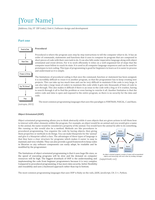Essay
Unit 06: Software Design and Development - 1. Know the features of programming languages P1, P2
- Course
- Institution
P1 Describe the application and limits of procedural, object oriented and event driven paradigms P2 Describe the factors influencing the choice of programming language Provide an information sheet covering the following paradigms: • Procedural • Object oriented • Event driven Consider t...
[Show more]



